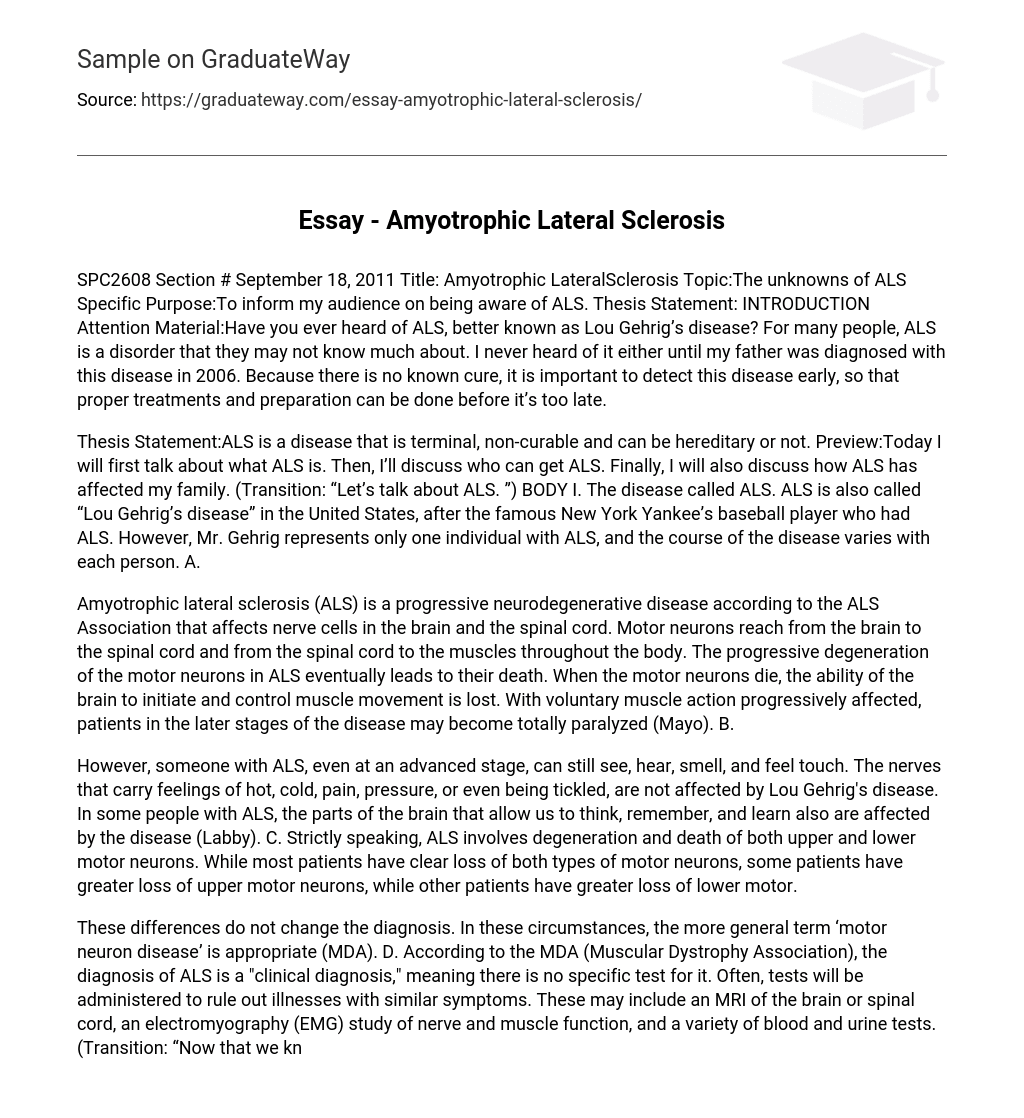INTRODUCTION
Have you ever heard of ALS, better known as Lou Gehrig’s disease? For many people, ALS is a disorder that they may not know much about. I never heard of it either until my father was diagnosed with this disease in 2006. Because there is no known cure, it is important to detect this disease early, so that proper treatments and preparation can be done before it’s too late.
Thesis Statement:ALS is a disease that is terminal, non-curable and can be hereditary or not. Preview:Today I will first talk about what ALS is. Then, I’ll discuss who can get ALS. Finally, I will also discuss how ALS has affected my family. (Transition: “Let’s talk about ALS. ”)
BODY
The disease called ALS. ALS is also called “Lou Gehrig’s disease” in the United States, after the famous New York Yankee’s baseball player who had ALS. However, Mr. Gehrig represents only one individual with ALS, and the course of the disease varies with each person.
Amyotrophic lateral sclerosis (ALS) is a progressive neurodegenerative disease according to the ALS Association that affects nerve cells in the brain and the spinal cord. Motor neurons reach from the brain to the spinal cord and from the spinal cord to the muscles throughout the body. The progressive degeneration of the motor neurons in ALS eventually leads to their death. When the motor neurons die, the ability of the brain to initiate and control muscle movement is lost. With voluntary muscle action progressively affected, patients in the later stages of the disease may become totally paralyzed (Mayo).
However, someone with ALS, even at an advanced stage, can still see, hear, smell, and feel touch. The nerves that carry feelings of hot, cold, pain, pressure, or even being tickled, are not affected by Lou Gehrig’s disease. In some people with ALS, the parts of the brain that allow us to think, remember, and learn also are affected by the disease (Labby).
Strictly speaking, ALS involves degeneration and death of both upper and lower motor neurons. While most patients have clear loss of both types of motor neurons, some patients have greater loss of upper motor neurons, while other patients have greater loss of lower motor. These differences do not change the diagnosis. In these circumstances, the more general term ‘motor neuron disease’ is appropriate (MDA).
According to the MDA (Muscular Dystrophy Association), the diagnosis of ALS is a “clinical diagnosis,” meaning there is no specific test for it. Often, tests will be administered to rule out illnesses with similar symptoms. These may include an MRI of the brain or spinal cord, an electromyography (EMG) study of nerve and muscle function, and a variety of blood and urine tests. (Transition: “Now that we know a little about what ALS is, let’s talk a little bit about who can get ALS”.
Who can be affected by ALS?
Although this disease can strike anyone, it is extremely rare in kids. According to the ALS Association, most people who develop Lou Gehrig’s disease are adults between 40 and 70, but younger and or older people can develop this disease. People of all races and ethnic backgrounds are affected. ALS is a rare disease that seems to strike men more often than women. Although this disease is rare, the National Institute of Heath recognizes ALS as one of the most common neuromuscular diseases worldwide.
More than 5,600 Americans are diagnosed with ALS each year. Approximately 35,000 people at any given time are living with ALS in the United States. The incidence of ALS is close to that of multiple sclerosis and four times that of muscular dystrophy (MDA). (Transition: “How ALS has affected my Family”. )
Back in 2005, my father was having some issues with muscle stiffness in his arms, and his legs were bothering him quite often, then he noticed he was starting to have some problems with slurring his speech and a couple other things were going on. After going to his doctor a few times to discuss these issues, they decided to do some testing to find out what was happening.
In 2006, my father was diagnosed with ALS. He was always a big (6’3”) man, 260 lbs. mostly healthy; a Navy man of 20 years of service, and never complained of much. Within the year of him waiting for a diagnosis, he was starting to deteriorate very quickly. He lost a lot of weight, was losing muscle tone in his arms and legs, and was having some breathing problems.
Soon after being diagnosed, this disease started to really progress. Soon my father had lost all function of his hands, he couldn’t feed himself anymore, or hold a picture in his hands, and it became very devastating to him and also me.
In 2009, my father now weighed 80 lbs. , was on a feeding tube, could barely speak, and was now bed ridden. The worst part of this whole process was watching him wither away, no treatment available, and physically suffering. The only thing he had left was his mind, everything else was gone. May 11th, 2009, my dad lost his life to this horrific disease. (Transition: “In conclusion”. )
CONCLUSION
So it was my pleasure to educate you a little on the disease known as ALS, who can get it, and how it has affected my life. Concluding Remark: Learning to educate one’s self is the best gift you could give yourself. ALS is a very fast paced degenerative disease that can strike almost anyone. It is just recently over the past 10 years starting to get the attention of many different research clinics.
A lot of people have never heard of ALS until they or a family member is diagnosed with it. Although there is not a cure yet for ALS, knowing the signs and early detection and medical treatment, some people can live with ALS for many years, having a productive life. Early detection IS the key.





